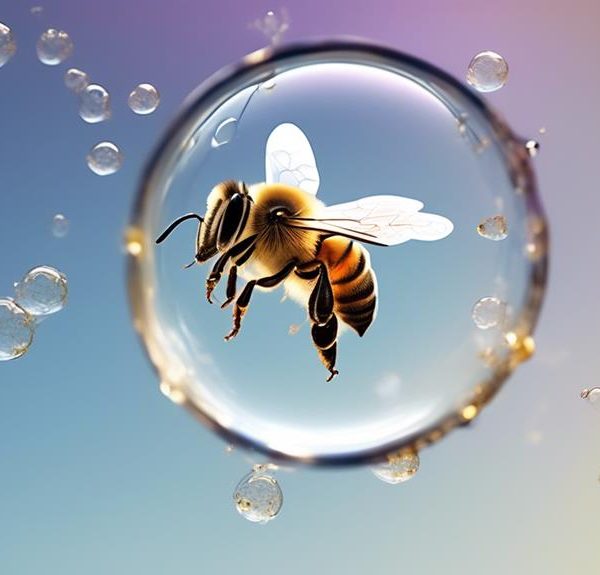An intriguing exploration into bumble bees' peculiar hovering behavior, revealing secrets of their survival, mating, and social structure.
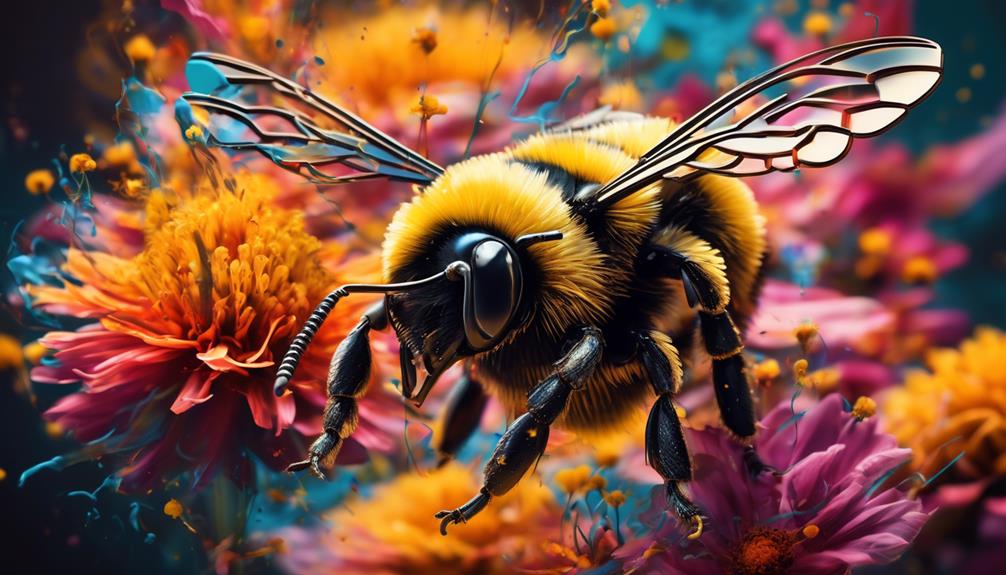
Why Is a Bumble Bee Hovering Same Spot?
You've seen them, you've questioned them, and you've probably wondered about them: those bumble bees that hover in the same spot, seemingly without purpose. What on earth could they be doing? Why do they seem to defy the very nature of their busy, buzzing brethren, choosing instead to linger in one place?
Well, as it turns out, there's a fascinating, almost secretive world behind this seemingly strange behavior. It's a world that intertwines with the very essence of their survival, their mating rituals, and their complex social structure. Yet, to truly appreciate the depth of this peculiar spectacle, one must venture further into the world of these humble hoverers.
Key Takeaways
- Bumble bees hover in the same spot to collect nectar and pollen for survival, indicating a rich source of food.
- Hovering is a complex behavior that involves a remarkable balance between power and precision, driven by muscular, neural, and aerodynamic forces.
- Bumble bees' highly developed visual system and gyroscopic sensory organs play a crucial role in maintaining a stable hover.
- Environmental conditions, physical state, and instinctive behaviors can influence a bumble bee's ability to hover in a specific spot.
Understanding Bumble Bee Behavior
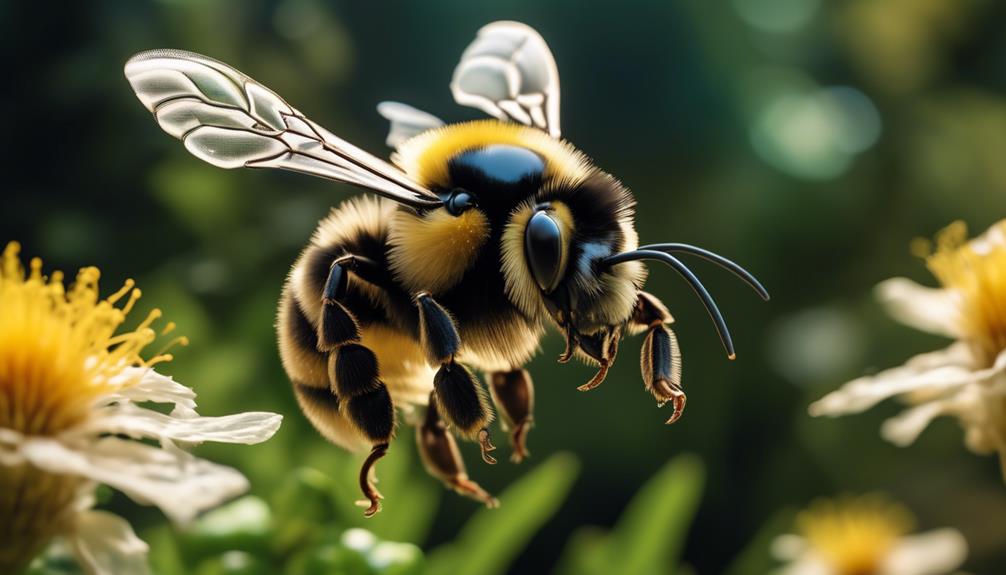
To fully grasp why a bumble bee might hover in the same spot, it's essential to delve into the intricacies of their behavior, the factors influencing it, and the underlying biological mechanisms. You see, these aren't random actions but rather purposeful behaviors driven by innate needs and environmental cues.
For instance, you may have noticed a bee hovering around a particular flower. It's not because they're indecisive or lost, but because they're collecting nectar and pollen, essential for their survival and that of their colony. Bees are meticulous creatures. They'll hover over the same spot if they've detected a rich source of food.
Moreover, a bee's ability to hover is a remarkable feat of nature's engineering. It involves a complex interplay of muscular, neural, and aerodynamic forces. Bees have a rapid wing beat frequency, beating their wings over 200 times per second, generating lift that allows them to hover in place. This precise control of flight mechanics, coupled with their sensory perception of the environment, enables them to stay in one spot even in the face of wind or other disturbances.
The Art of Bumble Bee Hovering
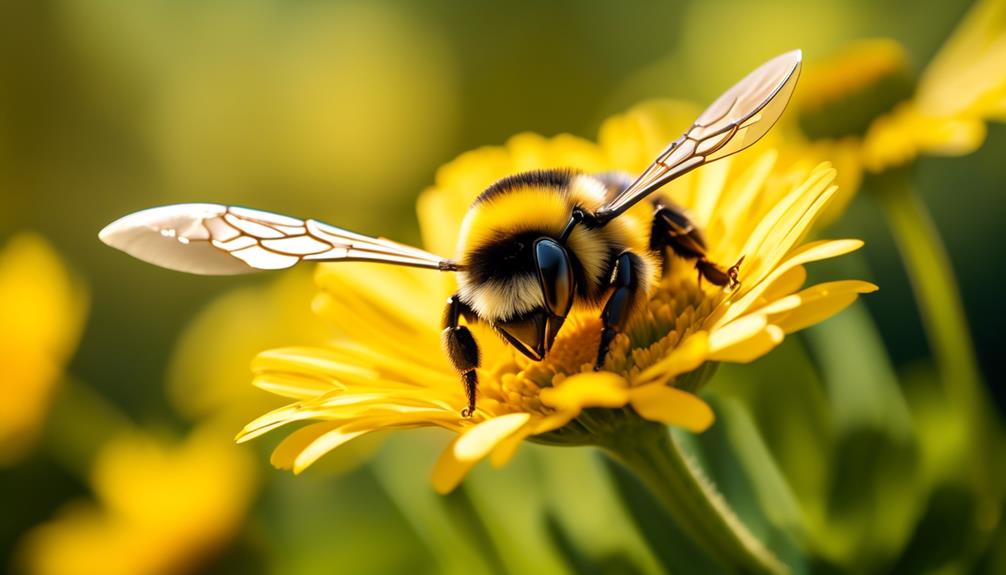
Delving into the art of bumble bee hovering, you'll find it's not just about beating wings, but a masterful control over dynamic forces, demonstrating a remarkable balance between power and precision. Bumble bees, you'll discover, have to manage a complex interplay of lift, drag, weight, and thrust, all within the constraints of their tiny insect bodies.
Their wings beat at an impressive 130-240 beats per second, generating a vortex of air that creates lift, propelling them upwards. The alternating wing beats, you'll find, make for a complex pattern of air flow that's meticulously managed by the bee in its hovering maneuver.
But it's not just a physical phenomenon. It's also a marvel of sensory and neural prowess. Bumble bees, you'll find, are equipped with a highly developed visual system and gyroscopic sensory organs that provide constant feedback on position and motion. Their brains process this information in real-time, adjusting wing beats, body tilt, and more to maintain a stable hover.
Factors Influencing Hovering Habits

While the mechanics of bumble bee hovering are indeed fascinating, it's equally intriguing to examine the various factors that influence these hovering habits. Several elements come into play, including environmental conditions, the bee's physical state, and its behaviors driven by instinct and survival needs.
Let's consider the environment first. Wind and temperature can greatly affect a bee's ability to hover. Strong winds may force a bee to hover in place as it fights against the gusts. Cold temperatures, on the other hand, may slow down its metabolism, thus reducing its energy for flight and leading to hovering.
Next, consider the bee's physical state. Health, age, and energy levels can all influence hovering behavior. An older or ill bee may lack the strength for sustained flight, resulting in more hovering. Similarly, a bee low on energy might hover while it searches for food sources.
Lastly, instinctive behaviors play a role. A bee might hover while it maps its surroundings, identifies potential threats, or locates a mates or food. It's a complex interplay of factors, but understanding them helps us appreciate the nuances of these fascinating creatures' behaviors.
Bumble Bees and Territory Marking

In the world of bumble bees, hovering isn't merely about wind resistance or energy conservation; it's also a crucial part of their territory marking behavior. As a bumble bee, you'd adopt a particular flight pattern to assert your control over a specific zone. This territorial behavior is particularly evident in males, who are fiercely protective of their space.
The act of hovering is often paired with the release of pheromones to create a scent mark, providing a chemical signature that warns off intruders. As you may know, bees have an incredible sense of smell. Thus, these scent marks are a powerful signpost, indicating that the territory is already claimed.
However, it's not a one-time event. To maintain your dominance, you'd need to revisit and renew your scent marks regularly. This process is why you often notice a bumble bee hovering in the same spot, seemingly without purpose. They're not lost or confused; they're simply performing an essential task in their daily routine, reinforcing their territorial claim and ensuring the security of their space.
The Role of Hovering in Mating Rituals
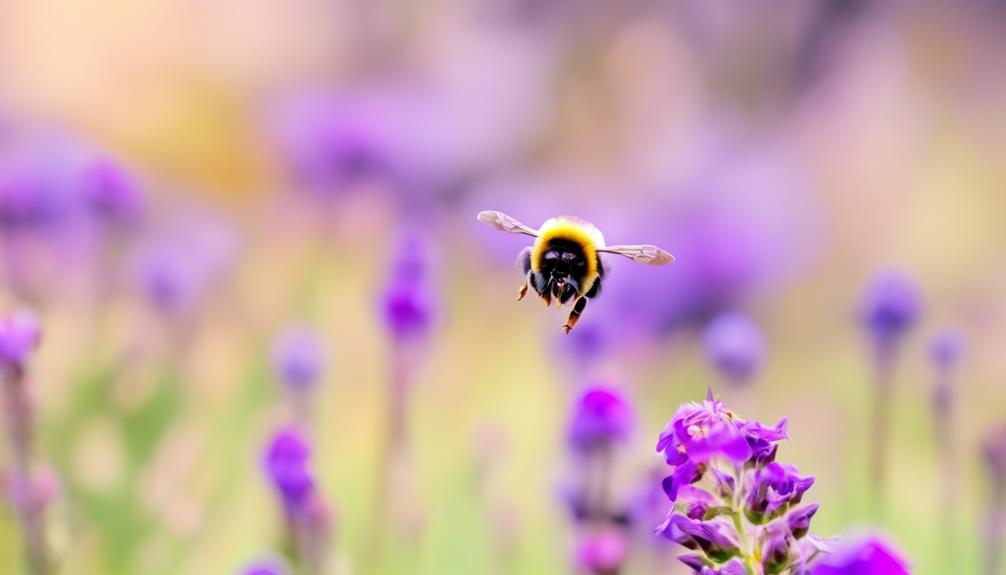
Beyond territory marking, hovering also plays an integral role in bumble bee mating rituals. In these complex dances, the male bee's ability to hover is paramount in attracting a female bee. As you observe, a male bumble bee will hover in one spot, displaying his strength and stamina to potential mates. It's a fascinating display of aerobatic prowess, designed to impress and attract.
The female bee, in turn, evaluates the hovering performance. She'll carefully assess the male's stamina, agility, and hovering stability. If she's suitably impressed, she'll engage in an intricate dance with the male, a prelude to mating.
However, there's more to this hovering than meets the eye. The buzzing sound produced during hovering is also a crucial element of the mating ritual. It's not just random noise; it's a nuanced, sonic signal that communicates the male's health and vitality. Scientists have found that females prefer males with a lower-pitched buzz, which typically indicates a larger and more powerful bee.
Frequently Asked Questions
What Is the Average Lifespan of a Bumble Bee?
You're curious about the average lifespan of a bumble bee. It's quite a fascinating topic!
Typically, a worker bee's lifespan is between 2-6 weeks in the summer. However, queen bees live up to a year.
Over winter, they hibernate underground and emerge in spring to lay eggs and start new colonies.
This lifespan can vary depending on the species and environmental factors, but it's a general guideline for these busy insects.
How Many Different Species of Bumble Bees Are There?
You're probably curious about the diversity within the bumble bee species. There's quite a bit! In fact, there are about 250 different species of bumble bees worldwide. They're mostly found in the Northern Hemisphere, but can also be found in South America.
Each species has unique traits and behaviors. That's a lot of bumble bee variety to consider! It's fascinating how much diversity exists in our natural world, isn't it?
What Predators Do Bumble Bees Face in Their Natural Habitats?
Bumble bees, like many creatures, face numerous threats in their natural habitats. Predators such as birds, spiders, and insects like dragonflies often prey on them. Even certain mammals, like badgers, can pose a threat by destroying their nests.
However, it's important to note that predators aren't the only danger. Pesticides, habitat loss, and climate change also significantly impact their survival.
How Does Climate Change Impact the Survival of Bumble Bees?
Climate change affects you, the bumble bee, in several ways. Rising temperatures can disrupt your hibernation, affecting your survival. They can also alter the flowering times of plants you depend on for food.
Furthermore, climate change may expand the range of your predators and parasites. In extreme cases, it can lead to habitat loss.
It's clear that climate change poses a serious threat to your existence.
What Role Do Bumble Bees Play in the Ecosystem Beyond Pollination?
Besides pollination, you'd be surprised how vital bumble bees are to our ecosystem. They're a key part of the food chain, providing sustenance for birds and other insects.
They also aid in soil health through their nesting habits, excavating underground channels that help with aeration and nutrient distribution.
Conclusion
So, you've observed a bumble bee hovering in the same spot. It's simply nature's marvel at work.
This behavior is influenced by factors like territory marking, mating rituals, and more. It's an intricate dance, a testament to the complex world of these tiny creatures.
Understanding this can help us appreciate their role in our ecosystem.
So next time you spot a hovering bumble bee, remember it's more than just a buzzing insect, it's a marvel of nature's design.

